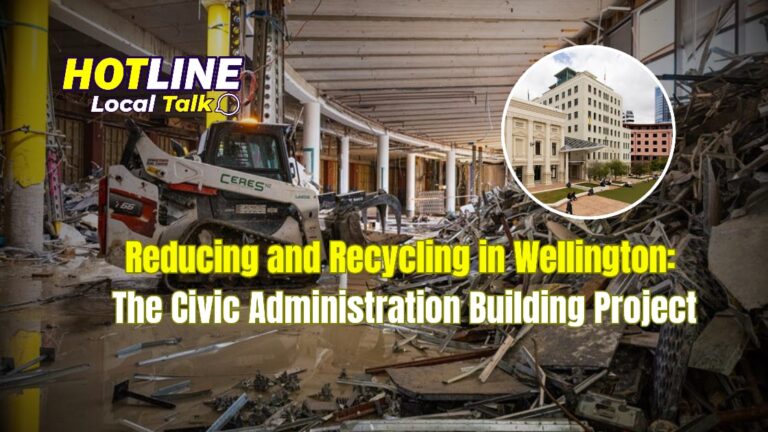The Civic Administration Building (CAB) in Wellington, severely damaged in the 2016 Kaikoura earthquake, is now undergoing a significant demolition and recycling process. Since April, Wellington City Council has focused on minimising waste from this large project, recycling nearly 80% of the demolition material. This approach not only supports sustainable practices but also aligns with Wellington’s broader environmental goals, making the CAB project a model of responsible urban development.
Picture source: wellington.govt.nz
A Strong Commitment to Sustainability
With LT McGuinness at the helm, the project places a strong emphasis on environmental sustainability. Site manager Rob Janes leads efforts to reduce landfill contributions and environmental impacts by sorting, reusing, and recycling a large portion of the building materials. Key components like steel, concrete, and copper cabling have been carefully separated by type and recycled. For example, steel has been categorised by grade before being sent to recycling, while the building’s pre-cast concrete has been processed into aggregate for redevelopment projects within the Hutt Valley. These measures contribute significantly to reducing the carbon footprint associated with demolition work.
Picture source: wellington.govt.nz
Community Contributions: Reusing Office Equipment
Beyond recycling, LT McGuinness has focused on repurposing a wide range of items from the building, contributing to local schools and charitable organisations. Items such as tables, chairs, dishwashers, and carpet tiles have been donated for new use. Lights and kitchenware have also found new homes. This initiative has helped ensure that these resources benefit the community, reducing waste and promoting a circular economy that values reuse over disposal.
Picture source: filfurniture.co.nz
Supporting Wellington’s Zero-Waste Goals
Wellington City is committed to a zero-waste future, with ambitious targets to divert 50% of construction and demolition waste from landfills by 2030, rising to 70% by 2035. Waste Minimisation Manager Renee Rushton has praised the CAB project as a significant step toward these goals. “The amount of recyclable material diverted from landfill is very encouraging,” she says, noting the importance of partnerships with environmentally committed companies like LT McGuinness to reach the city’s targets.
Picture source: wellington.govt.nz
The Future of Te Ngākau Precinct
As Wellington envisions a future-focused city, the CAB site’s redevelopment within the Te Ngākau Civic Precinct will prioritise sustainability. Programme Manager Te Ngākau Farzad Zamani has emphasised that sustainable methods will be integral in developing the area, supporting a city that thrives alongside nature. Wellingtonians are invited to participate in the conversation, sharing their views on projects such as the City to Sea Bridge replacement and the future of surrounding public spaces. Until 13 November, residents can have their say on how to shape the area’s transformation, ensuring it meets the needs of future generations.
Picture source: Getty Images
A Model for Sustainable Urban Development
The CAB demolition exemplifies how urban projects can prioritise waste reduction and environmental sustainability. By recycling materials and repurposing assets, Wellington sets a standard for eco-friendly construction practices that align with the city’s long-term vision for zero waste and a vibrant, sustainable future. Through projects like these, Wellington demonstrates how cities can actively pursue both progress and preservation, ensuring that future development works in harmony with the natural environment and local communities.
CONTRIBUTE
Have stories, yarns, mad scoops, or community news to share. We often pay for awesome content and life shattering stories. What have you witnessed?


